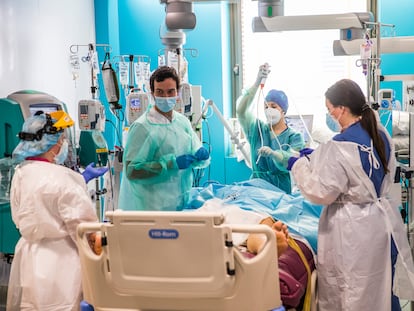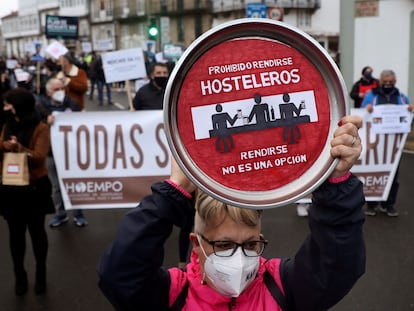Spain on track to vaccinate 70% of adult population with at least first dose by June
With the shots forecast to arrive, the country will be able to provide full protection to 22.7 million people by the start of summer
Despite the interruptions to supply, the recent suspension of the use of the Oxford-AstraZeneca vaccine and the slow pace of the European Union’s campaign when compared to the United States, Israel or the United Kingdom, Spain is still on course to get its hands on enough Covid-19 vaccine doses to vaccinate 70% of the adult population by the summer. Spain has committed to reaching this level by September 21, but if there are no problems with the supply levels that have been agreed upon and the campaign can be rolled out as planned, this could happen as early as June.
Thierry Breton, the head of the collective purchasing of vaccines for the European Union, stated on Sunday during an interview on French television that the forecast is to deliver between 300 and 350 million doses to the bloc’s 27 countries in the second quarter of the year. Being conservative, Spain is due around 30 million of these doses. Taking into account that there are 1.3 million doses in reserve, and nearly a million more due to arrive this week, that’s a total of 32.3 million doses. Considering the number of people who have already been vaccinated in Spain, this will be sufficient for the complete protection (i.e. two doses) of 58% of the population between the end of June and the start of July. By early June, however, at least 70% of the population may have had their first shot.
According to the latest Health Ministry data, 2.1 million people have received the full vaccination and another 2.1 million are awaiting the second dose
The key for reaching the higher figure of 70% will be for the manufacture of the vaccines to be ramped up as the months go by. The problems that have been seen until now would disappear should these plans be met. Even the failure of AstraZeneca to deliver what it has promised and the commercial battles that the pharmaceutical company is having with Europe would be just a minor obstacle that would not stop this figure from being reached, provided there are no new problems with other manufacturers. There could, however, be a bottleneck if EU states are unable to administer the doses that they have at their disposal.
While it is still unknown exactly how many doses of each vaccine will arrive, the Spanish Health Minister Carolina Darias said on Sunday during a television interview with La Sexta channel that in the second quarter of the year Spain will receive 5.5 million doses of the Janssen vaccine, which only needs one shot for full protection. This allows for calculations that were, until now, impossible, given that the speed of the campaign will vary substantially if just a single injection is required.
For Spain to reach 70% of its adult population, it will need to vaccinate 27.4 million people. According to the latest Health Ministry data, there are already 2.1 million people with full vaccinations and another 2.1 million who have had one dose and are awaiting the second. What’s more, it should be taken into account that the under-55s who have tested positive for the virus in the previous six months will only be given one dose, given that this is sufficient for a complete activation of the immune system. While this figure is not public, an estimate can be made based on the data from the Health Ministry and the age ranges that the Carlos III Health Institute has been publishing since June. There are likely around 1.2 million people in this situation.

If you take into account the 5.5 million people who will receive the single-dose Janssen vaccine, as well as the 2.1 million people who are awaiting their second dose, plus the 1.2 million under-55s who have already had the coronavirus and as such will only receive one shot, the result is that to completely inoculate this population a total of 8.8 million doses are needed. Adding the 2.1 million people who have already had their two shots, that gives a total of 10.9 million people who will have been completely immunized.
If the 8.8 million doses are subtracted from the 32.3 million doses forecast, in the second quarter that would leave another 23.5 million shots. With these, the two doses could be administered to nearly 11.8 million more people. Adding this to the aforementioned 10.9 million people gives a total of 22.7 million people – 58% of the adult population.
Half of Spaniards do not trust the Oxford-AstraZeneca vaccine, according to a recent survey
But this will not be the exact order of the campaign. If all of the vaccines that arrive are administered, there will be a higher percentage of people with the first dose and a lower percentage with the complete protection. And from July, the arrival of vaccines should speed up.
The conclusion, with these forecasts, is that any bottleneck will not be with the number of doses but rather with the speed at which the system is able to administer them. In an interview with EL PAÍS, Health Minister Darias sought to assure the public that this would not be a problem, with extra staff to be drafted in as necessary.
It will also be necessary to see whether the public rejects the AstraZeneca vaccine, given its troubled history so far. This is despite the fact that the European Medicines Agency, the World Health Organization and the Health Ministry all insist that it is safe and that its benefits far outweigh its risks. Even so, half of Spaniards do not trust the medication, according to a recent YouGov survey.
English version by Simon Hunter.
Tu suscripción se está usando en otro dispositivo
¿Quieres añadir otro usuario a tu suscripción?
Si continúas leyendo en este dispositivo, no se podrá leer en el otro.
FlechaTu suscripción se está usando en otro dispositivo y solo puedes acceder a EL PAÍS desde un dispositivo a la vez.
Si quieres compartir tu cuenta, cambia tu suscripción a la modalidad Premium, así podrás añadir otro usuario. Cada uno accederá con su propia cuenta de email, lo que os permitirá personalizar vuestra experiencia en EL PAÍS.
¿Tienes una suscripción de empresa? Accede aquí para contratar más cuentas.
En el caso de no saber quién está usando tu cuenta, te recomendamos cambiar tu contraseña aquí.
Si decides continuar compartiendo tu cuenta, este mensaje se mostrará en tu dispositivo y en el de la otra persona que está usando tu cuenta de forma indefinida, afectando a tu experiencia de lectura. Puedes consultar aquí los términos y condiciones de la suscripción digital.
More information
Últimas noticias
Most viewed
- Sinaloa Cartel war is taking its toll on Los Chapitos
- Reinhard Genzel, Nobel laureate in physics: ‘One-minute videos will never give you the truth’
- Oona Chaplin: ‘I told James Cameron that I was living in a treehouse and starting a permaculture project with a friend’
- Why the price of coffee has skyrocketed: from Brazilian plantations to specialty coffee houses
- David King, chemist: ‘There are scientists studying how to cool the planet; nobody should stop these experiments from happening’











































